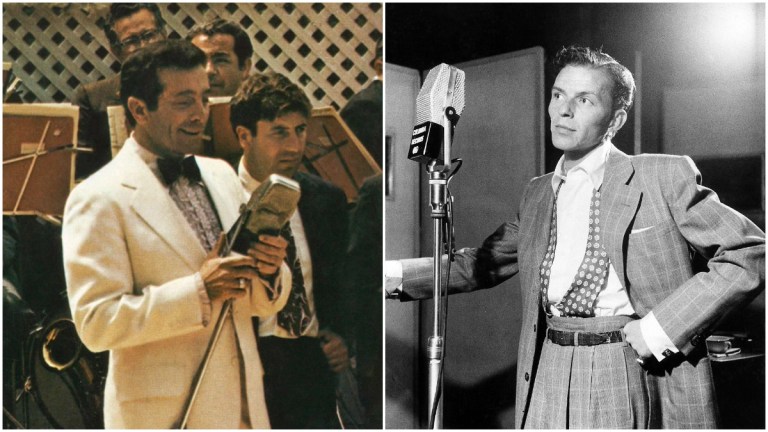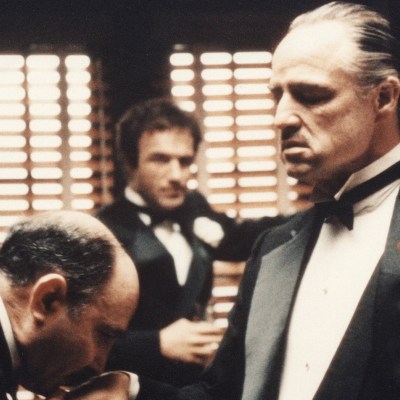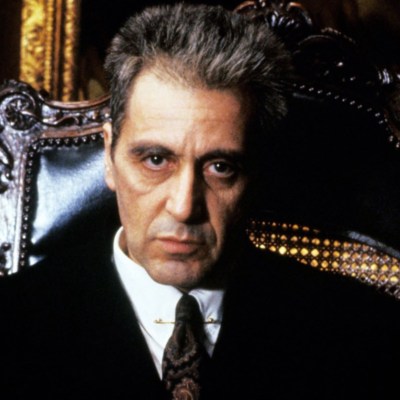The Godfather and Frank Sinatra’s Real History with the Mafia
The Godfather’s Johnny Fontane was a mix of a few Italian singers, but only one chairman of the board…

The Godfather, which opened 50 years ago on March 24, 1972, is the premiere gangster film of all time, elevating the genre to high art and taking all of filmmaking with it. Francis Ford Coppola adapted Mario Puzo’s best-selling novel to tell the story of an immigrant family crashing the dance of the American dream. The singer is Johnny Fontane, paying homage to his benefactor, Don Vito Corleone (Marlon Brando). The character may also be something less than a tribute to The Chairman of the Board, Frank Sinatra.
“Frank, I make fun of you, but what could you do to me,” Don Rickles asked Sinatra from the stage at his 80th Birthday Celebration in 1995. Audiences and investigative agencies have been asking the same question for years! Jokes and gossip about Ol Blue Eyes’ ties to organized crime are legendary. But is Frank Sinatra an actual OG?
The Godfather never uses the word “mafia” or the phrase “cosa nostra,” according to the extras included on Paramount Pictures’ 4K Ultra HD edition of The Godfather Trilogy. The film and novel are seen through the eyes of the Corleone family, a fictional mix of many elements of each of organized crime’s Five Families.
The novel includes historical figures which were left out of the movie. Al Capone is mentioned, as are some of the original fathers of crime families. In The Godfather Papers, Puzo says he wrote the novel “entirely from research. I never met a real honest-to-god gangster,” until after the book was published. This is also when he was briefly introduced to a dismissive Sinatra, who may or may not have been the inspiration for one of its most recognizable characters.
Puzo maintained the character of Johnny Fontane wasn’t based on Sinatra, even though he admits in his book The Godfather Papers that he wouldn’t show the working manuscripts to the famed singer’s lawyers while it was being written. The similarities between Fontane and Sinatra appeared so conspicuous, the singer was infuriated.
The author said Johnny Fontane was a composite of a few real-life singers, including Al Martino, who plays the role in the film The Godfather. The novel was informed by a story Puzo heard about Martino getting beaten to a pulp and run out of town for trying to get a better deal for his appearances in a mob-run nightclub.
Family Ties and Associations
In Puzo’s novel, Johnny Fontane was born and raised in Little Italy, and was a childhood friend to the Corleone children. He was encouraged to sing by his music teacher, Sister Immaculata, and his godfather Vito had friends who owned venues to perform. By contrast, Francis Albert Sinatra was born on Dec. 12, 1915, in Hoboken, New Jersey, where wise guys were commonplace and crime was a realistic career option.
Frank’s father was Sicilian-born Antonino Sinatra, a bantamweight boxer who fought under the name Marty O’Brien. His mother was Natalina Garaventa, an Italian-born midwife rumored to perform illegal abortions which got her the nickname “Hatpin Dolly.” Frank’s uncle, Bob Garavante, was part of the Genovese Family. The Sinatras ran a local speakeasy during Prohibition. Frank was given a ukulele for his 15th birthday, and began singing locally.
Throughout his career, Sinatra denied any professional connections to the mob, outside of playing venues they owned, even as he was regularly photographed with known gangsters in those casinos and nightclubs. He also openly attended and performed at social functions.
Puzo and Coppola both cited Salvatore Bonanno’s marriage to Rosalie Profaci as the inspiration for the opening sequence of Connie Corleone’s (Talia Shire) wedding in the classic film. He was heir apparent to the Bonanno crime family, she was the daughter of the head of the Profaci Family, now known as the Colombo Family. The ceremony was attended by Tony Bennett.
However, the Corleone compound wedding in the film more closely resembles the Hasbrouck Heights, New Jersey wedding of the daughter of Genovese Family underboss Guarino “Willie” Moretti. Not only did Sinatra sing, but he brought Dean Martin, Jerry Lewis, and Milton Berle with him to perform. Moretti was Sinatra’s godfather, favors may have been owed. Just like Johnny Fontane owed a debt for past services rendered by his godfather, Vito Corleone.
A Little Help Starting Out
In Puzo’s book, Fontane hit national stardom while singing under contract to bandleader Les Halley and wanted to renegotiate. Vito Corleone personally offered $10,000 to buy out the contract. Halley said no. Vito returned the next day and within an hour the bandleader signed the release for a certified check of $1,000. The Don had brought a friend.
“There are men in this world who go about demanding to be killed,” Vito says in the novel. “They argue in gambling games; they jump out of their cars in a rage if someone so much as scratches their fender. These people wander through the streets calling out, ‘Kill me, kill me.’ Luca Brasi was such a man.” So was Willie Moretti.
Morretti was the cousin of Luciano/Genevese Family Boss Frank “The Prime Minister” Costello, one of the models for the character Vito Corleone. Although Sinatra denied it during the 1981 Nevada Gaming Commission hearings, Moretti allegedly helped the singer get bookings in New Jersey clubs. This led to a 1939 recording contract with popular band leader Tommy Dorsey.
By 1941, Sinatra was the bobby-soxers’ dream boy, making the young girls faint at live shows and cracking the charts. He wanted a better deal or a chance to go solo. Dorsey refused to release Sinatra from his existing contract. According to legend, negotiations lasted one meeting. Moretti reputedly opened by sticking a gun in Dorsey’s mouth. The trombone-playing bandleader sold Sinatra’s contract for one dollar.
Mr. Corleone Never Asks a Second Favor
During the wedding festivities, Fontane asks his godfather for another favor. The singer wants to branch out into serious acting and is very interested in a part in a war film currently in production. There is a character so much like Johnny that he wouldn’t even have to act. The studio head Jack Woltz (John Marley) knows the kid with the olive oil voice is perfect for the star-making part, but he’s trying to run Fontane out of town because of a personal grudge.
Woltz blames Johnny for ruining a young actress he was grooming as protégé. Vito tells his godson to spend time with his family. This is another parallel between the two. Sinatra divorced his wife Nancy and married Hollywood star Ava Gardner in 1951, the same year his contract with MGM was terminated.
Vito sends Hagen to negotiate with Woltz, who is guilty of other offenses in the novel, and in scenes shot, but cut, for the film. The Hollywood bigshot turns down what he sees as a strong-arm attempt, and exposes all his own weaknesses. Woltz wakes up to find the severed head of his prize stud horse, Khartoum, in his bed. He casts Fontane in the war picture. Johnny sends flowers to his godfather.
The horse’s head in the film is real. Production designer Dean Tavoularis arranged for a dog food manufacturer to deliver the head of an already-killed horse in dry ice on the day the scene was shot. But there is no evidence any movie producer ever woke up with the head of his favorite thoroughbred under the sheets. Rumors about Sinatra using muscle to get cast in the 1953 film From Here to Eternity have persisted since production began, but no credible details have ever surfaced.
The novel dedicates whole arcs to the singer, and his friends, family, and tawdry episodes, which the film omits. In the book Vito also helps Johnny win an Oscar for the picture he got as a wedding day favor. Sinatra won the Academy Award for Best Supporting Actor for his role as Pvt. Angelo Maggio in From Here to Eternity.
The Odds Are Always With the House
In The Godfather, after Al Pacino’s Michael Corleone, who is now running the family business, convinces Moe Green (Alex Rocco) to take the “offer he can’t refuse,” he asks Fontane for a favor.
“We feel that entertainment is going to be a big factor in drawing gamblers into the casinos,” Michael explains. “We’re hoping that you’ll sign a contract agreeing to appear five times a year. Perhaps convince some of your friends in the movies to do the same.” Johnny is all too pleased to do this family service.
Sinatra never headlined the Flamingo, but he socialized with Benjamin Siegel, who Moe Green is based on. Frank was a fixture at Las Vegas casinos since his first appearance at the Desert Inn on Sept. 13, 1951. After being spotted there with the Chicago Outfit’s Sam Giancana in 1963, the Nevada Gaming Commission took away Sinatra’s casino license.
The Rat Pack made the Sands their home base starting in October 1953, culminating in a period where they’d make movies like Ocean’s Eleven during the day and perform all night. Sinatra even appeared on the local Las Vegas television show hosted by Frank “Lefty” Rosenthal, played as Sam “Ace” Rothstein by Robert De Niro in Martin Scorsese’s Casino. Rosenthal was so connected, the Nevada Gaming Commission barred him from having anything to do with gambling in Las Vegas in 1976.
While much has been made of Sinatra’s standoff against Puzo, the singer spent so much time in casinos that he knew the best bets. Sinatra put out feelers to buy the rights to The Godfather so he could produce it himself.
“Francis, I’d gladly play the Godfather for you,” Sinatra told Coppola, according to Puzo’s book The Godfather Papers and Other Confessions. “I wouldn’t do it for those guys at Paramount. But I’d do it for you.”
The Godfather only includes two scenes with Johnny Fontane. Sinatra, who did not want his public image hurt by stories of criminal ties, had power in Hollywood. He could have exerted influence to get some of the novel’s scenes cut from the final film, although they may have been cut by Coppola just to keep focus on the Corleone Family.
Feds Don’t Respect Nothing
In spite of Sinatra’s denials, the FBI amassed a file of 1,275 pages on the singer. J. Edgar Hoover said Sinatra had a “hoodlum complex,” who liked playing it tough and had friends who could back him up. Wiseguys wanted to be in the singer’s inner circle, and he did his best to juggle and accommodate.
Sinatra had a record. He was arrested and charged with “carrying on with a married woman” in New Jersey, in 1938. The FBI’s investigations were sparked by the mass-hysteria the singer inspired in his fans. Anonymous sources claimed a new Hitler could come into power just because people could be convinced crooners like Sinatra are okay. The FBI also investigated Sinatra’s claims that he was unable to serve in World War II due to medical reasons. It was true. The forceps used in his birth marred his face, permanently damaging Sinatra’s ears.
The federal files feature lurid phrasings like “associations with criminals and hoodlums” and “accusations of being a dope racketeer.” There are accounts of gifts from Joseph and Charles Fischetti, cousins of Al Capone, who continued running illegal gambling operations in the Chicago outfit; reports about drinking late into the night with Detroit mobsters Anthony and Vito Giacalone; and pages on Sinatra’s appearance at the wedding of Philadelphia mob boss Angel Bruno’s daughter.
Whole dossiers, as well as several books like Kitty Kelley’s His Way: The Unauthorized Biography of Frank Sinatra, and more than a few documentaries have scrutinized Sinatra’s friendship with Chicago mob boss Sam Giancana. Several claim Sinatra asked Giancana to deliver union votes for John F. Kennedy’s 1960 campaign, and introduced Kennedy to Giancana’s girlfriend, Judith Campbell Exner. She allegedly served as a liaison between the president and mobster while plans were developed to assassinate Fidel Castro.
Sinatra even had to call on the feds for help. In 1963, three men kidnapped his son, Frank Sinatra, Jr. The FBI told Sinatra to pay the ransom so they could track down the kidnappers through the money. Sinatra knew he was being watched. He requested and received his FBI file through the Freedom of Information Act in 1979 and 1980.
In spite of 40 years of surveillance, no government agency ever found enough evidence to tie Sinatra to any criminal enterprise. The singer/actor was also cleared of any subversive activities in spite of being a fierce defender of anti-racist initiatives, legislation, and movements, and an outspoken critic of the Red Scare.
Sinatra was one of the founding members of the Committee for the First Amendment, which supported the “Hollywood Ten” screenwriters and directors blacklisted for Communist Party ties. Sinatra admitted membership, never named names, and never stopped working. He did it his way.
The Godfather Trilogy 4K Ultra HD edition is available from Paramount.


